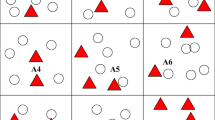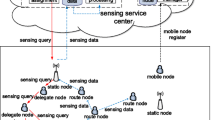Abstract
Human-carried or vehicle-mounted sensors can be exploited to collect data ubiquitously for urban sensing. In this work, we study a new coverage problem, opportunistic coverage, to characterize the sensing quality of such people-centric sensing systems. Compared with the traditional static coverage and dynamic coverage in sensor networks, opportunistic coverage has some unique characteristics caused by the requirements of urban sensing applications and human mobility features such as spatio-temporal correlation, hotspots effects and randomness. In order to achieve good trade-off between energy consumption and coverage quality, we propose an offline node selection mechanism and an online adaptive sampling mechanism. The former can select the minimum number of nodes to achieve coverage requirements, based on the history trajectories of the given set of nodes, and the latter can help each selected node to decide whether to perform the sampling task at some time adaptively. Based on a real human mobility dataset and a taxi mobility dataset, extensive simulation results evaluate that our proposed models and mechanisms are effective and efficient in terms of energy consumption and coverage quality.









Similar content being viewed by others
Notes
In the rest of this paper, without loss of generality, we use the terms “people”, “users”, and “nodes” interchangeably.
Because no one taxi has at least one GPS report every 30 min during 6:00-12:00 on Feb. 2 and Feb. 8, the mobility traces on the 2 days will not be used.
References
Ahmed, A., Yasumoto, K., Yamauchi, Y., & Ito, M. (2011). Distance and time based node selection for probabilistic coverage in people-centric sensing. In Proceedings of IEEE SECON, pp. 134–142.
Burke, J., Estrin, D., Hansen, M., Parker, A., Ramanathan, N., Reddy, S., & Srivastava, M. (2006). Participatory sensing. In Workshop on World-Sensor-Web, co-located with ACM SenSys.
Campbell, A., Eisenman, S., Lane, N., Miluzzo, E., & Peterson, R. (2006). People-centric urban sensing. In Second ACM/IEEE International Conference on Wireless Internet (WiCon), pp. 18–31.
Campbell, A., Eisenman, S., Lane, N., Miluzzo, E., Peterson, R., Lu, H., Zheng, X., Musolesi, M., Fodor, K., Ahn, G.et al. (2008). The rise of people-centric sensing. IEEE Internet Computing, 12(4), 12–21.
Cardei, M., & Wu, J. (2006). Energy-efficient coverage problems in wireless ad-hoc sensor networks. Computer communications, 29(4), 413–420.
CENS/UCLA: Participatory sensing/ urban sensing projects. http://research.cens.ucla.edu/.
Chvatal, V. (1979). A greedy heuristic for the set-covering problem. Mathematics of Operations Research, 4(3), 233–235.
Cuff, D., Hansen, M., & Kang, J. (2008). Urban sensing: Out of the woods. Communications of the ACM, 51(3), 24–33.
Dutta, P., Aoki, P., Kumar, N., Mainwaring, A., Myers, C., Willett, W., & Woodruff, A. (2009). Common sense: Participatory urban sensing using a network of handheld air quality monitors. In Proceedings of ACM SenSys, pp. 349–350.
Eisenman, S. (2008). People-centric mobile sensing networks. Ph.D. thesis, Columbia University.
Eisenman, S., Lane, N., & Campbell, A. (2008). Techniques for improving opportunistic sensor networking performance. In Proceedings of IEEE DCOSS, pp. 157–175.
Eriksson, J., Girod, L., Hull, B., Newton, R., Madden, S., & Balakrishnan, H. (2008). The pothole patrol: using a mobile sensor network for road surface monitoring. In Proceedings of ACM MobiSys.
Ganti, R., Pham, N., Ahmadi, H., Nangia, S., & Abdelzaher, T. (2010). Greengps: A participatory sensing fuel-efficient maps application. In Proceedings of ACM MobiSys, pp. 151–164.
Ghosh, A., & Das, S. (2008). Coverage and connectivity issues in wireless sensor networks: A survey. Pervasive and Mobile Computing, 4(3), 303–334.
Hefeeda, M., & Bagheri, M. (2007). Randomized k-coverage algorithms for dense sensor networks. In Proceedings of IEEE INFOCOM, pp. 2376–2380.
Hsu, W., Dutta, D., & Helmy, A. (2012). Csi: A paradigm for behavior-oriented profile-cast services in mobile networks. Ad Hoc Networks, 10(8), 1586–1602.
Hu, S., Wang, Y., Huang, C., & Tseng, Y. (2009). A vehicular wireless sensor network for CO2 monitoring. In Proceedings of IEEE Sensors, pp. 1498–1501.
Hull, B., Bychkovsky, V., Zhang, Y., Chen, K., Goraczko, M., Miu, A., et al. (2006). Cartel: A distributed mobile sensor computing system. In Proceedings of ACM SenSys, pp. 125–138.
Kumar, S., Lai, T., & Balogh, J. (2004). On k-coverage in a mostly sleeping sensor network. In Proceedings of ACM MobiCom, pp. 144–158.
Lane, N., Eisenman, S., Musolesi, M., Miluzzo, E., & Campbell, A. (2008). Urban sensing systems: Opportunistic or participatory? In Proceedings of the 9th ACM workshop on mobile computing systems and applications, pp. 11–16.
Lane, N., Miluzzo, E., Lu, H., Peebles, D., Choudhury, T., & Campbell, A. (2010). A survey of mobile phone sensing. IEEE Communications Magazine, 48(9), 140–150.
Lee, Y., Ju, Y., Min, C., Kang, S., Hwang, I., & Song, J. (2012). Comon: Cooperative ambience monitoring platform with continuity and benefit awareness. In Proceedings of ACM MobiSys, pp. 43–56.
Li, M., Cheng, W., Liu, K., Liu, Y., Li, X., & Liao, X. (2011). Sweep coverage with mobile sensors. IEEE Transactions on Mobile Computing, 10(11), 1534–1545.
Liu, B., Brass, P., Dousse, O., Nain, P., & Towsley, D. (2005). Mobility improves coverage of sensor networks. In Proceedings of IEEE ACM MobiHoc, pp. 300–308.
Meguerdichian, S., Koushanfar, F., Potkonjak, M., & Srivastava, M. (2001). Coverage problems in wireless ad hoc sensor networks. In Proceedings of IEEE INFOCOM, pp. 1380–1387.
Rana, R., Chou, C., Kanhere, S., Bulusu, N., & Hu, W. (2010). Ear-phone: An end-to-end participatory urban noise mapping system. In Proceedings of ACM/IEEE IPSN, pp. 105–116.
Rhee, I., Shin, M., Hong, S., Lee, K., & Chong, S. (2008). On the levy walk nature of human mobility. In Proceedings of IEEE INFOCOM, pp. 924–932.
Scellato, S., Musolesi, M., Mascolo, C., Latora, V., & Campbell, A. T. (2011). Nextplace: A spatio-temporal prediction framework for pervasive systems. In The 9th International Conference on Pervasive Computing, pp. 152–169.
Shin, M., Tsang, P., Kotz, D., & Cornelius, C. (2009) Deamon: Energy-efficient sensor monitoring. In Proceedings of IEEE SECON, pp. 1–9.
Srinivasan, A. (1995). Improved approximations of packing and covering problems. In Proceedings of the twenty-seventh annual ACM symposium on Theory of computing, pp. 268–276.
Srivastava, M., Abdelzaher, T., & Szymanski, B. (2012). Human-centric sensing. Philosophical Transactions of the Royal Society A: Mathematical, Physical and Engineering Sciences, 370(1958), 176–197.
Wang, W., Srinivasan, V., & Motani, M. (2007). Adaptive contact probing mechanisms for delay tolerant applications. In Proceedings of ACM MobiCom, pp. 230–241.
Wang, X., Wang, X., & Zhao, J. (2011). Impact of mobility and heterogeneity on coverage and energy consumption in wireless sensor networks. In Proceedings of IEEE ICDCS.
Wang, Y., & Wu, H. (2007). Delay/fault-tolerant mobile sensor network (dft-msn): A new paradigm for pervasive information gathering. IEEE Transactions on Mobile Computing, 6(9), 1021–1034.
Wimalajeewa, T., & Jayaweera, S. (2010). Impact of mobile node density on detection performance measures in a hybrid sensor network. IEEE Transactions on Wireless Communications, 9(5), 1760–1769.
Yang, D., Xue, G., Fang, X., & Tang, J. (2012). Crowdsourcing to smartphones: Incentive mechanism design for mobile phone sensing. In Proceedings of ACM MobiCom.
Zhao, D., Li, X. Y., & Ma, H. (2014). How to crowdsource tasks truthfully without sacrificing utility: Online incentive mechanisms with budget constraint. In Proceedings of IEEE INFOCOM.
Zhao, D., Ma, H., & Liu, L. (2012) Mobile sensor scheduling for timely sweep coverage. In Proceedings of IEEE WCNC, pp. 1771–1776.
Zheng, Y., Liu, Y., Yuan, J., & Xie, X. (2011). Urban computing with taxicabs. In Proceedings of ACM Ubicomp.
Acknowledgments
This work is supported by the National Natural Science Foundation of China under Grant No. 61332005, No. 61272517 and No. 61133015, the Funds for Creative Research Groups of China under Grant No. 61121001, the Specialized Research Fund for the Doctoral Program of Higher Education under Grant No. 20120005130002, and the Key Technologies R&D Program of China under Grant No. 2011BAC12B03.
Author information
Authors and Affiliations
Corresponding author
Rights and permissions
About this article
Cite this article
Zhao, D., Ma, H. & Liu, L. Energy-efficient opportunistic coverage for people-centric urban sensing. Wireless Netw 20, 1461–1476 (2014). https://doi.org/10.1007/s11276-014-0687-0
Published:
Issue Date:
DOI: https://doi.org/10.1007/s11276-014-0687-0




